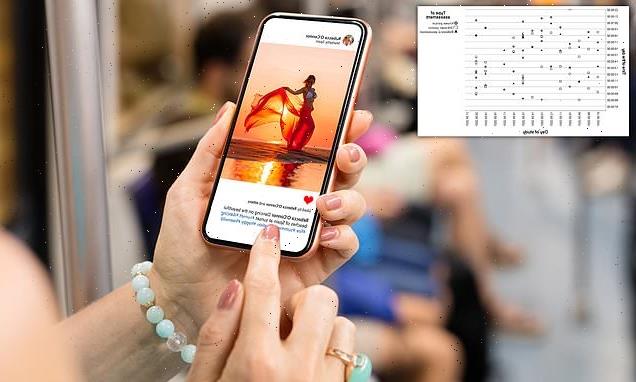Children are watching porn in the UK simply by ticking a box to say they are over the age of 18, report warns – as experts call for adult sites to do more to protect youngsters
- Under the Online Safety Bill, users will have to prove they are over 18
- But a report found OnlyFans was the only one to have adopted such checks
- Many of its smaller rivals still allow users to access adult material simply by self-declaring they are over 18
Children are watching porn in the UK simply by ticking a box to say they are over the age of 18, Ofcom has revealed.
One adult website told the watchdog it had considered using age verification tools – but decided against as it would hit their bottom line too much.
Ofcom boss Dame Melanie Dawes accused platforms of ‘putting profits before child safety’ ahead of new internet laws being introduced to tackle the problem.
Children are watching porn in the UK simply by ticking a box to say they are over the age of 18, Ofcom has revealed (stock image)
A third of young men and one in six women had watched pornography by age 13
A third of young men and one in six young women had viewed pornography by the age of 13, troubling new data has revealed.
A major survey found half of the 72 per cent of men aged between 18 and 29 who have seen online pornography were exposed to it before they were teenagers.
Among women in the same age group, 61 per cent said they had watched online porn, with almost a quarter having first done so by the age of 13. Experts say early exposure to online pornography has led to an increase in sexually aggressive and abusive behaviour among teenagers.
Vanessa Morse, chief executive of The Centre to End All Sexual Exploitation (Cease), said: ‘These shocking statistics show the prevalence of children watching harmful pornography at a young age. We know that children are more susceptible to mental health problems associated with compulsive porn use such as anxiety, depression, loneliness.
‘It also interferes with working memory and concentration, which is obviously going to really impact children in school.’
Under the Online Safety Bill, users will have to prove they are over 18 to access porn – though it will be up to firms to decide how they vet customers.
A report published today however has found the UK’s largest video-sharing site for adult content, OnlyFans, was the only one to have adopted such checks.
Many of its smaller rivals still allow users to access adult material simply by self-declaring they are over 18 – often by just ticking a pop-up box or by putting in a date of birth.
Ofcom said it did not consider such measures to be appropriate age checks, adding it was clear the platforms were not ‘sufficiently equipped, prepared and resourced for regulation’.
While some asked for a payment card to access the content, Ofcom said this was not enough to ensure the customer was old enough as some could be held by under-18s.
Over the next year, Ofcom said adult sites ‘must have in place a clear roadmap to implementing robust age verification measures’ ahead of the Online Safety Bill.
The legislation will give Ofcom the power to hand out hefty fines of up to ten per cent annual turnover – or even block sites from being used in the UK.
Only adult websites that have user-generated content will be included under the Bill however, with critics warning companies could get around the rules by removing any material uploaded by users.
Ofcom’s latest report focused on OnlyFans and five other adult video sharing platforms (VSPs) – AdmireMe, Fanzworld, PocketStars, Xpanded and RevealMe.
OnlyFans has introduced age verification for all new UK subscribers using Yoti, third-party software that estimates people’s age using a selfie they upload.
The company claims the technology can guess whether users between 13 and 19-year-olds are under the age of 23 with over 99 per cent accuracy.
If a user fails this test, they go have to verify their age using ID such as a passport through. Anyone who refuses cannot set up an account.
Dame Melanie Dawes, Ofcom’s Chief Executive, said: ‘Today’s report is a world first. We’ve used our powers to lift the lid on what UK video sites are doing to look after the people who use them.
‘It shows that regulation can make a difference, as some companies have responded by introducing new safety measures, including age verification and parental controls.
‘But we’ve also exposed the gaps across the industry, and we now know just how much they need to do.
‘It’s deeply concerning to see yet more examples of platforms putting profits before child safety. We have put UK adult sites on notice to set out what they will do to prevent children accessing them.’
Campaigners have warned for years that vast amounts of porn readily available online were having a worrying impact on children’s attitudes to relationships.
Half of parents fear web porn gives youngsters an unrealistic view of sex and more than half of mothers think it casts women in a poor light, according to research.
WHAT ARE THE MOST COMMON TYPES OF VIRUS FROM PORN?
There are ten digital STIs that can harm your device when you’re looking at adult content, according to computer security firm Kaspersky Lab.
These are:
1. Trojans – They might masquerade as innocent programs, but they carry a harmful payload.
2. Drive-by downloads – Cybercriminals look for insecure web sites and plant a malicious script into the code on the pages. These take advantage of any unpatched applications on your computer and infect them automatically
3. Click-jacking – Click-jacking involves tricking someone into clicking on one object on a web page while they think they are clicking on another. Clickjacking can be used to install malware, gain access to a victim’s online accounts or to enable their webcam.
4. Tinder bots – These are automatic programs designed to masquerade as real people on a dating site to lure users into clicking on them, with the aim of tricking the victim into disclosing confidential data.
5. Cat-Phishing – This is when cybercriminals pose on dating sites or chat rooms, encouraging people to click on links for live sex chat or adult images.
6. Ransomware – Cybercriminals use ‘blockers’ to stop the victim accessing their device, often telling them this is due to ‘illegal pornographic content’ being identified on their device. Anyone who has accessed porn online is probably less likely to take the matter up with law enforcement.
7. Worm – This is a program that replicates, but does not write its code to other files: instead, it installs itself once on a victim’s device and then looks for a way to spread to other devices.
8. Pornware – This could be a legitimate program, but might be adware installed by another malicious program, designed to deliver inappropriate content to the victim’s device.
9. Spyware – Software that enables an attacker to secretly obtain information about the victim’s online activities and transmit it covertly from their device.
10. Fake Anti-virus – Fake anti-virus programs prey on people’s fear of malicious software which they believe may have been installed whilst looking at porn.
Source: Read Full Article


